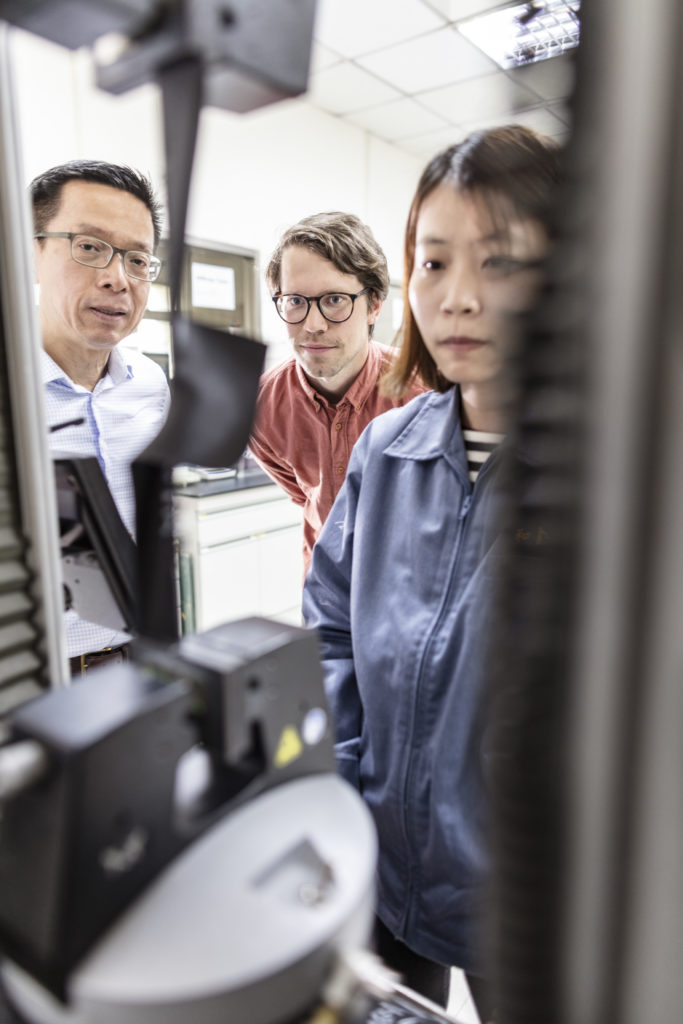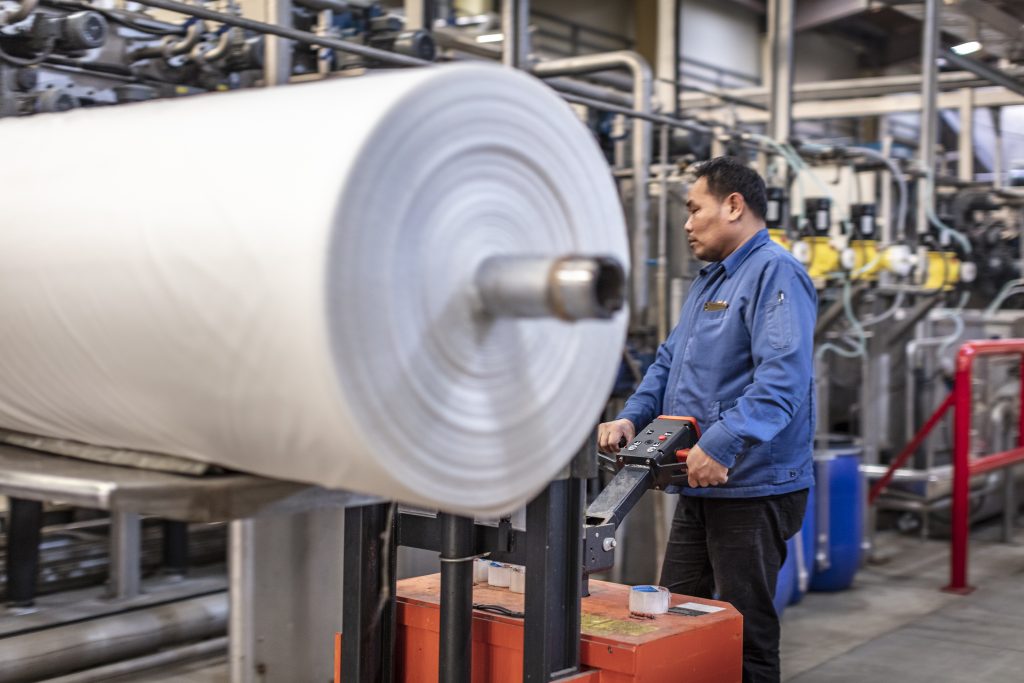Making the future
Waterproof, sustainable & extra durable. Meet our newest material: Bergshell.
It doesn’t look like much from the outside, but appearances can be deceiving. Inside the brutalist, grey building it’s clean, ordered and well-planned. A few people wander the factory floor, keeping a watchful eye on the machines doing all the hard work. Upstairs are neat conference rooms, offices and test labs where Fjällräven product developers Niklas Kull and Svante Björkroth are discussing the minutiae of a new material, Bergshell, with Charles Jwo, one of the owners of Ho-Yu Textile Company.

Charles points to the various contraptions in one of the labs, “this one tests abrasion resistance, this one is for tear strength.” The two Swedes are happy; the material prototypes have delivered the kind of ‘hand-feel’ or texture they were looking for.
“For us it’s important to ensure the material has Fjällräven’s ‘DNA’. People need to know it’s a Fjällräven material even if they can’t see the logo,” explains Svante.
As they move onto discussions about lamination, filament yarn and air texturing, things start to get more complex. It’s clear that Charles and his team at Ho-Yu aren’t short on technical expertise. That’s partly why we chose to work with them to produce Bergshell. The other part is because of their sustainability focus.
A green revolution
Ho-Yu was founded in 1964 by Charles’s father and two friends. They took advantage of the west’s declining textile industry, seeing potential growth in the east. Ho-Yu quickly became one of Taiwan’s premier textile factories, largely due to its location in Taipei City, close to businesses with international ties. However, after a particularly strong typhoon season in the mid-eighties, bringing deluge after deluge of rain, Ho-Yu moved to its current, more spacious location in Guanyin.

“The rains brought huge floods,” explains Charles. “I remember that the water used in the factory, which was filled with toxic chemicals, would end up in the rice fields and local reservoirs. So my father and his partners took the decision to move the factory. They didn’t want to risk people’s health. This was the first step in our journey to becoming more environmentally friendly.”
This was a rare – and somewhat audacious – move in 1987, even more so because it was in Asia. Looking at it now though, it made total sense. And it pales in significance to everything else Ho-Yu Textile Company is doing in terms of sustainability. Examples include closed systems to minimise fumes on the factory floor, re-using solvents to help drive the machines, on-site microbial water-recycling and using mostly recycled materials – both pre- and post-consumer fabrics. Some are rather bold, such as trialling new low energy production techniques, investing more than $1 million on a – failed – experiment testing a water-saving colouring technique.
“It didn’t work, so it was a very expensive piece of equipment, but you’ve got to try. If it had worked it would have been fantastic. But now it’s just a headache,” says Charles and laughs.

We all hop in Charles’s car and drive to Ho-Yu’s weaving factory, five minutes away. 156 machines are creating a racket. The looms gyrate rhythmically, weaving the warp and weft into one, long roll of fabric. There is no traditional shuttle scuttling from left to right. Instead a jet of water shoots across the surface. This modus operandi increases output and uses less energy than conventional methods. The result is a more uniform, higher-quality fabric and a lingering odour of damp in the factory. But that’s not all. To create Bergshell, Ho-Yu has used a special air-texturing technique. Air is blown along the surface of the two yarns as they’re woven together. This scuffs and fluffs the resulting fabric a little. You can’t see it; but it produces a more abrasion-resistant fabric.
Let’s rewind a little
A few years ago customers started asking why we didn’t have a waterproof backpack in our range. Our answer was because the combination of G-1000 Heavy Duty and a rain cover provided all the weather protection and durability most trekking backpacks needed. But then came Bergtagen.
Bergtagen is our mountaineering collection, comprising a system of layers, from wool thermals to synthetic insulation and an Eco-Shell waterproof jacket. When we launched the collection in September 2017 it was without a backpack. And it felt somewhat incomplete.

Fjällräven backpacks in the range at the time didn’t offer the kind of toughness and waterproofness that was required in demanding mountainous landscapes. So our hardware designers started searching. The challenge proved gargantuan. Finding waterproof materials wasn’t hard; getting the right durability was also not too much of a stretch, but getting them both and meeting Fjällräven’s sustainability standards was a tall order.
“We knew cotton wouldn’t cut it,” explains Svante. Even G-1000 HD wouldn’t be durable enough for rugged alpine use. The waterproof materials we looked at were too shiny and flashy to be Fjällräven. They weren’t that hardwearing either. Plus we had to find a supplier who shared our vision on sustainability. We can’t just produce a functional and durable material. According to Fjällräven design guidelines, our materials have to be sustainable too.”
That’s where Ho-Yu comes in.
Svante, Niklas and Charles have moved into a conference room. Different fabrics are strewn across the table. To the naked, untrained eye they all look identical. But there are subtle differences: lamination type, weight, thickness. Niklas, the designer, is talking about how the material looks and feels. He scrunches it, twists it, pulls it. He then looks at the lamination, rubs his hand over it and asks Charles what level of waterproofness it offers? Svante, on the other hand, as the buyer, is more interested in costs. He needs to know the total sum of the parts. He’s rational, considered, polite yet firm. This is a collaboration. Fjällräven designers don’t just tell Ho-Yu and its partners what to do. Likewise, Ho-Yu doesn’t just produce a fabric and try to sell it to us. It’s a process. One that requires lengthy telephone calls, Skype meetings, long trails of emails and even visits to the factory in Taiwan.
Together we’re better
The design team begin the process by looking for a partner, a company that shares our sustainability vision but that can also produce to the quality we demand, at the volumes we need. Once that partner is found, meetings are set up. Can we work with them? What would the relationship be like? Can they deliver what they promise at a price that’s right? And will our other suppliers – the people that use the material to create products – be happy working with them? In the beginning there are a lot of questions. Getting the answers can take time.

Next comes prototyping. Bergshell is a completely new material, for both Fjällräven and Ho-Yu. It’s made from recycled nylon, something Ho-Yu has been working with for more than a decade. The new aspects are the combination of lamination and the air-textured rip-stop technique. When it all comes together you have Bergshell.
Once the Fjällräven team is relatively happy with the material they can use it to create products, in this case backpacks. Then comes a period of intense product testing on the Fjällräven side, providing on-going feedback and areas of improvement or change for Ho-Yu and the teams in Vietnam, who produce our backpacks using Bergshell. This continues, back and forth, emails, calls and meetings, for many months. Finally, consensus is agreed, smiles broaden, hands are shaken.
“It’s an on-going process of improvement,” explains Niklas. “we challenge them to be better. We learn what is possible. Together we can ensure the best possible outcome.”
It’s all in the details
The resulting material is quite special. Bergshell has a flat ripstop construction. Conventional ripstop fabrics have an uneven surface with the ripstop threads taking bumps and scuffs first as they are slightly raised. This protects the filament yarn beneath, but wears out the ripstop threads, leaving the material open to wear and tear. Bergshell’s flat ripstop construction, on the other hand, means abrasion is spread evenly over the entire surface of the fabric, considerably increasing the amount of abrasion it can withstand.
This has been achieved by combining a smooth filament yarn with an air-textured yarn. The smooth yarn has a high tear strength, but isn’t so resistant against abrasion. The air-textured yarn, on the other hand, is the converse. The air texturing, as mentioned previously, has a fuzzy surface which offers improved abrasion resistance, though it compromises tear strength. But together you get the best of both worlds: strong and tough against both abrasion and tearing.
By adding a TPU laminate and PFC-free DWR impregnation the material is also waterproof (up to 20,000mm). And the yarn is made from partly recycled nylon that’s Global Recycled Standard certified.
“We’re really proud of the outcome,” says Niklas. “Our goal when we started developing Bergshell was to create a waterproof fabric with clear Fjällräven DNA, which we’ve now done. But we think we’ve gone one step further and really pushed the limits of what we thought was possible. Not only is the material made from recycled nylon, but because it’s so resistant to abrasion and tearing it will last a really long time. The feedback we’ve got from the test team of mountain guides has also been great. So we’re pleased.”
Niklas has used Bergshell to create a slew of technical backpacks. The first, Bergtagen, is for the mountaineering range. The second is Keb, designed for long-distance treks. The third is actually a new range, called Ulvö. It’s a collection of small- to medium-sized daypacks, including a roll-top which offers a completely waterproof backpack solution.

Upon leaving the conference room we head out through the factory. Great, hulking rolls of fabric in a multitude of colours line one wall, their vividness incongruous against the grey concrete. Knobs, buttons and wheels are the only external details of otherwise uniform machines. Beneath the smooth, innocuous shell lies a complex compilation of cables, cogs and coils. It’s a metaphor for Bergshell. From a distance it looks like any other Fjällräven material: matt, slightly textured, tactile. But close up, that’s where “the magic happens,” as Niklas says. Move the material around and depending on how the light hits it you see the threads criss-crossing in different directions. Touch it and you feel the air-textured ripstop. Use it in nature and you won’t want anything else.
Images: Håkan Wike
